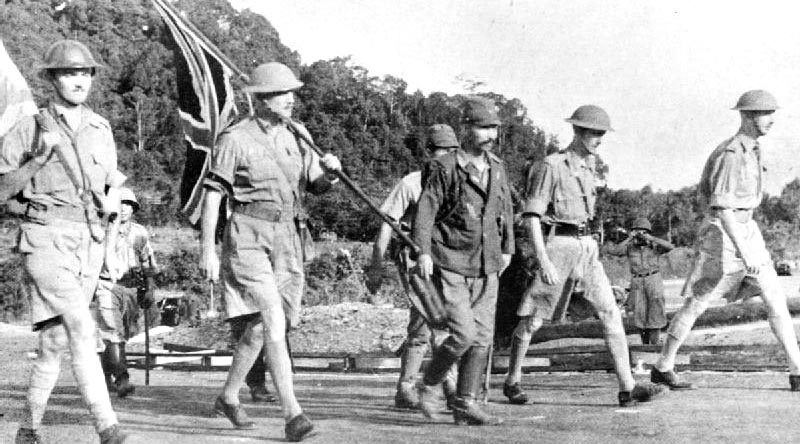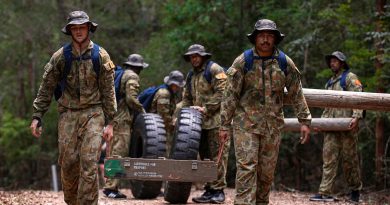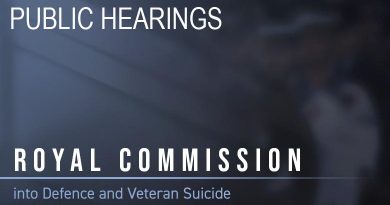Fall of Singapore remembered with service at new WWII memorial
Share the post "Fall of Singapore remembered with service at new WWII memorial"

A public National Service will be held today at the Australian Ex-Prisoners of War Memorial in Ballarat, Victoria, to remember the Fall of Singapore 75 years ago.
Veterans of World War II and former prisoners of war will be joined by Governor-General, His Excellency, General the Honourable Sir Peter Cosgrove AK MC (Retd) and Her Excellency Lady Cosgrove, His Excellency Fook Seng Kwok, High Commissioner for Singapore, and Mrs Pearl Kwok, and other dignitaries at the service.
CAPTION: Lieutenant-General Arthur Ernest Percival, led by a Japanese officer, walks under a flag of truce to negotiate the capitulation of Allied forces in Singapore, on 15 February 1942.
Minister for Veterans’ Affairs Dan Tehan said that on today’s 75th anniversary of the Fall of Singapore, Australians would pause and reflect on the lives lost and the more than 15,000 Australian soldiers who were taken prisoner.
A service to unveil the Garden of the Grieving Mother, a new memorial dedicated to the families of servicemen and women who have lost their lives in war, will take place at the Arch of Victory in Sturt Street, Ballarat, hosted by the Arch of Victory/Avenue of Honour Committee.
The Malayan Campaign, which ended with the Fall of Singapore, lasted from 8 December 1941 to 15 February 1942. On 15 February 1942, Allied forces on Singapore laid down their arms. Some 1800 Australians lost their lives or were listed as missing in action in the fighting for Malaya and Singapore, more than 1300 were wounded and more than 15,000 were take as prisoners of war.
Those who surrendered on Singapore were held captive, firstly at Changi and, as the war continued, in locations across South East and East Asia, including Japan.
Mr Tehan said he was very pleased that a group of Australian veterans of the Fall of Singapore had been able to travel to Ballarat to join the National commemorations, organised by the Department of Veterans’ Affairs in association with the Trustees of the Australian Ex-Prisoners of War Memorial.
“Today we remember and commemorate the courage and sacrifice of Australians during the Second World War, and we take this opportunity, on the 75th anniversary of the Fall of Singapore, to reflect on that time in our history and to thank our veterans for their service,” Mr Tehan said.
“It is vital we continue to honour the memory of those who served and to use these occasions to reflect on our experience of war, the values our service men and women fight to protect and the cost we pay for doing so.
“The Garden of the Grieving Mother will be an important memorial because it recognises and honours that loss felt by the family and friends when they lose a loved one in defence of our nation.”
By 31 January 1942, all British Empire forces had withdrawn from the Malay peninsula onto Singapore Island. On 8 February, the Japanese landed in the north-west of the island and within six days they were on the outskirts of Singapore city, which was also now under constant air attack.
Many of the troops had been shocked at the apparent lack of defences on the island. The men were battle-weary and the Australians had lost nearly 700 men fighting in Malaya since 14 January, with hundreds of others sick or wounded. Only one trained reinforcement unit, the 2/4th Machine Gun Battalion, arrived from Australia. Other last-minute reinforcements sent were untrained and ill-equipped for battle.
The Japanese had prepared for the invasion of Singapore with a heavy bombardment. They began their amphibious landings on the north-west of the island, where the Strait of Johore is narrowest. This area was held by the Australian 22nd Infantry Brigade but late on the night of 8 February the Japanese made their way through undefended sections. Twenty-four hours later a second Japanese landing force struck between the Causeway and the mouth of the Kranji River, an area held by the Australian 27th Infantry Brigade. By the morning of 10 February there were Japanese troops on most of north-west Singapore.
The Australian, British and Indian troops tried to hold the Japanese at various defensive lines but after two days many of their dreadfully depleted battalions had to be reorganised into composite units. A counter-attack on 10-11 February failed and on 12 February General H Gordon Bennett, the Australian commander, began moving his near-exhausted 8th Division AIF units into a perimeter just a few kilometres out of the city. By the next day the Japanese were within five kilometres of the Singapore waterfront. The entire city was now within range of Japanese artillery.
Official evacuations from Singapore had begun in late January and continued until almost the last moment. RAAF squadrons had been evacuated before the Japanese invaded the island and the remaining RAN warships were ordered to leave. Some merchant ships also got away carrying evacuees from the path of the Japanese. The warships’ main operational tasks were escort duties, and the fleet based in Singapore included the destroyer HMAS Vampire and the sloop HMAS Yarra, which arrived late in January, along with several corvettes. The corvettes in the 21st Minesweeping Flotilla swept the sea lanes and conducted anti-submarine patrols. HMA Ships Toowoomba, Wollongong and Ballarat reinforced the original four corvettes, HMA Ships Bendigo, Burnie, Goulburn and Maryborough. The last 65 Australian Army nurses stationed in Singapore were ordered to board the Vyner Brooke, which sailed on 12 February. Their colleagues, who had sailed in the Empire Star the previous day, reached Australia, but only 24 of the nurses who sailed in the Vyner Brooke survived to return to Australia in 1945 after the war had ended.
By 14 February the Japanese had captured Singapore’s reservoirs and pumping stations. The bombing, fighting and heavy shelling continued; many of the troops, separated from their units, wandered around aimlessly and the hospitals were crowded and overflowing. Some troops were deserting and others had become separated from their units. Hard fighting continued but on 15 February Lieutenant General Arthur Percival, the British commander in Singapore, called for a ceasefire and made the difficult decision to surrender. He signed the surrender document that evening at the Ford Factory on Bukit Timah Road. After days of desperate fighting, all British Empire troops were to lay down their arms at 8.30 that night. More than 100,000 troops became prisoners of war together with hundreds of European civilians who were interned.
Despite his instruction to Australian troops to stay at their posts, General Bennett and two of his staff officers escaped, controversially, from Singapore on the night of the surrender and eventually reached Australia.
Courtesy www.ww2australia.gov.au
.
The fall of Singapore was a pivot point for Australian alliances and the Australian psyche – turning to America to protect what was once England’s ‘responsibility’ – the Australian mainland.
.
.
.
.
.
.
.
.

.
.
Share the post "Fall of Singapore remembered with service at new WWII memorial"






